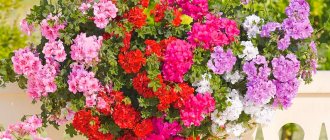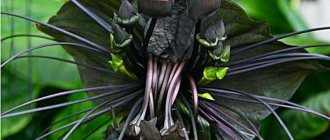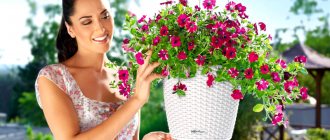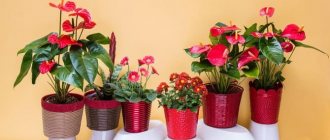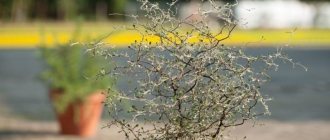What varieties of hanging trees are best to plant on the site?
Let's look at some garden hanging plants that bloom beautifully and are easy to care for.
Option #1 – hanging begonia
A wonderful plant with small scarlet or bright red flowers on delicate, flexible and long stems. The flowers resemble small chrysanthemums. This is a rather whimsical plant that does not tolerate heat at all and needs frequent watering. Begonia should not be placed in bright sun; you need to choose a shaded corner for it. If summers are too hot in your area, this plant will not be suitable for the garden.
If the ampelous begonia feels good in your garden, it will delight you with abundant flowering. Even one pot with such a beauty will decorate a gazebo, veranda or terrace. Try to keep the plant out of direct sunlight
Option #2 – pelargonium
One of the most unpretentious plants is pelargonium (or geranium). Geranium loves the sun, warmth, and is not afraid of drought. The plant will not disappear if you are away for a long time and there is no one to water it.
There are many types of pelargonium that grow well outdoors and indoors. Boxes with blooming pelargonium can be placed in any sunny place in the garden, under the windows. This plant also looks good in flower beds
Option #3 – lobelia
Lobelia is a hanging plant that is also well suited for the garden; it can grow in both sun and slightly shaded areas. Lobelia should grow in moist, humus-rich soil.
Using lobelia you can make a kind of “edging” for some garden buildings, or, for example, a fence
Option #4 – ampelous petunia
Ampelous petunia is known to everyone. Its bright, beautiful flowers of purple, lilac and red colors can be found in summer not only in gardens, but also as decoration for city balconies and cafe terraces. Petunia needs regular watering, a well-lit, warm place and fertile soil. It will delight you with its flowering until the onset of cold weather.
An option for decorating a path using a hanging petunia. Such two-tier pots on beautiful wrought iron stands are sold in flower shops, and the colorful flowers in them look simply luxurious
Option #5 – bacopa
Bacopa is a perennial, but in our country it is more often used as an annual plant. Blooms throughout the warm period, grows in sun or partial shade. The soil should be watered moderately so that it does not dry out or become overly moist.
Bacopa is known for its ease of care. There are varieties with white flowers - as in this photo, as well as with lilac and violet colors
Flowering hanging plants are, of course, favorites among those who like to decorate their garden. But there are also non-flowering varieties of ampels that can transform any unremarkable or even dull place into a pleasant place to relax.
Option #6 – dichondra
Ampelous dichondra is a new product in our flower market. This is a deciduous plant whose shoots can reach one and a half meters in length. Dichondra leaves are small and round in shape. May be green or silver. The plant is perfect for both vertical gardening and for creating a carpet on the ground.
This is the kind of carpet that dichondra can form on the ground. You can place the shoots symmetrically, directing them along the tile line
Dichondra, hanging from a flowerpot, looks quite unusual. This cascade of green or silver lush greenery will add charm to any space in the garden.
There are many types of hanging plants, this is only a small part of them. All of the above plants grow well in our gardens, they do not require special care, but turning the site into a wonderful corner with their help is not at all difficult
You just need to pay attention to them, care for them, and water them in a timely manner.
Also, in hanging pots and wide flowerpots, limnanthes is grown as an hanging crop. Read more about this plant: https://diz-cafe.com/rastenija/limnantes-vyirashhivanie-iz-semyan.html
Conditions for hanging crops
When arranging hanging flowering gardens, it is very important to create suitable conditions for the hanging plants themselves, among which there are light-loving and shade-tolerant varieties. When forming a hanging basket, it is important to select crops with similar growing conditions
In the bright sun, lobelia, ivy-leaved pelargonium, verbena, and dichondra feel great. Petunia is a universal plant for vertical gardening; the plant tolerates bright light and partial shade.
Pelargonium ivy-leaved
There are special crops for growing in the shade, the queen of which is tuberous begonia. Ampelous varieties of this plant with small leaves and huge multi-colored flowers look perfect in any corner of the garden. Begonia can be planted not only in hanging flowerpots; compositions of these plants are ideal for flowerpots with high legs.
Advice. Among the hanging crops, there are moisture-loving species and drought-resistant species.
It is important to select the plant varieties that make up the basket, taking this aspect into account.
You cannot plant hanging crops in windy places - the leaves and petals quickly lose their fresh appearance and lose their decorative effect. It is best to place decorative flower pots under the protection of building walls or decorative landscape structures.
It is very important to choose the right height for the flowering hanging pots - they should not interfere with the movement of people, the flowers should not be injured by the clothes and bags of passers-by
What plants are suitable for hanging cultivation?
For hanging cultivation, choose colorful plants that bloom beautifully or have long shoots hanging from the pots. Nasturtium or petunia have this property to some extent. And viola, snapdragon and pelargonium (geranium) are not climbing or drooping, but colorful and meet all the requirements of ampelous floriculture. One way or another, all options are very suitable for decorative purposes when grown in hanging baskets. Nowadays, even small shrubs are used for planting in a hanging vase.
The most popular and well-known plants for hanging propagation are listed in the following list.
- Petunia is distinguished by its variety of colors, long flowering throughout the summer, and ease of care.
- Pelargonium (geranium) is a popular plant. Its conditions are warmth and sun, not too much watering, and tolerates drought.
- Ampelous begonia prefers a sunny place. In such conditions it is most beautiful, blooming with red flowers on long stems. Otherwise, it is not very demanding in terms of care.
- Verbena also does not require complex care and blooms for a long time. Grows well in loose, fertile soil and loves sun.
- Campanula belongs to the bellflower family and has stems that are more than 20 centimeters long and drooping. The flowers are white, light blue or slightly purple. The plant blooms very profusely and looks beautiful at the same time. A composition of two flowerpots with white and blue flowers is called “bride and groom”. Hang it on the window - as close to natural light as possible. But it does not tolerate strong sunlight.
- Ampelous fuchsia is a beautifully flowering indoor perennial plant. Graceful white-pink or purple flowers appear in autumn. Prefers moist soil, but not excessively. It is not recommended to expose it to direct sunlight.
- Viola - “pansy” is distinguished by pleasant-looking flowers with rich and varied colors, very decorative. There are special ampelous varieties of this plant.
In addition to those listed, in this type of floral design, hanging flowers for pots, the names of which are less known, are widely used.
- Surfinia, which is characterized by various shades of colors and abundant flowering. Grows quickly and reproduces vegetatively
- Lubelia with shoots hanging down like a waterfall, flowers of various colors: white, blue, pink. Blooms in June if sown on time.
- Bacopa is common in America and Europe, but is not yet popular enough here. Loves warmth and sun, which ensures flowering.
- Dichondra complements other plants by combining with them to form hanging cascades.
The fact that some hanging plants are not known to everyone does not diminish the importance of such a crop in decoration.
Hanging flowers for pots: hanging variety of shapes and colors
Almost all flower shops abound in hanging plants in the spring. Many people prefer to purchase ready-made options so that the area immediately shines with bright, vibrant shades. It would be a good idea for novice decorators to first familiarize themselves with the most common plants. This is not difficult, since there are a large number of photos of hanging flowers for pots on the Internet, and the names will easily stick in your memory when you carefully examine the plants.
The most common type of flower for hanging flower pots is petunia.
In order for the area to quickly shine with bright and vibrant shades in the spring, you can not grow, but buy ready-made versions of hanging flowers.
Such high popularity is explained by the following features of the plant:
- the flower is quite unpretentious;
- has a wide variety of shades;
- has a long flowering period - from spring to late autumn.
The flower loves slightly acidic soil, good light, and sufficient watering. Even if the plant has withered, it can be revived by shading it during the recovery period and increasing watering.
Surfinia is very similar to petunia. Externally, plants can be distinguished only by the more abundant flowering of the latter. The conditions for normal growing season are the same.
Until recently, until the dominance of petunias came, the explanation of what ampelous plants are began with pelargonium (geranium).
The most common types of flowers for hanging flowerpots are petunia and surfinia.
This flower has many advantages:
- drought resistant;
- does not require frequent watering;
- has phytoncidal properties;
- blooms from early spring to late autumn.
Grows on clay soils, loves sun.
Ceropegia may also be a good choice for beginners. A completely unpretentious flower, not even burdened by the need for frequent cutting of dry stems. You just need to plant it in slightly acidic soil with the addition of humus and place it in the sun. Ceropegia “suffers” from even slight partial shade.
On a note! It is necessary to apply fertilizers to the soil where hanging flowers grow with knowledge and caution.
The principle “the more the better” does not apply to this type of plant at all. Ampelous flowers love fertilizing, but it is important not to overdo it.
How to make a composition of ampelous plants
From hanging flowers you can grow a magnificent composition and even a real masterpiece of landscape design. Creeping plants will cover the soil with a “carpet” and create a background for the composition. Common loosestrife, dichondra and small periwinkle are suitable for this purpose. You can grow a dense “forest” from succulents.
Larger multi-rosette flowers should be placed in the center of the composition. They are used to grow shapes: a heart, a star, an animal’s face, etc. You can choose one of the brightest flowers and make it the center.
Falling plants must be grown at a certain height: they must rise above the rest of the composition. Flowerpots with high legs can be placed in the center or on the sides. Hanging flowerpots will decorate the walls. Climbing and climbing plants are ideal for decorating arches, walls, roofs and other vertical surfaces. They can even be woven into outbuildings.
The composition can be supplemented with foreign objects, for example, old baskets, boots and any other unnecessary things. You need to show your imagination: experiment with shapes, combine different shades, add unexpected details, place flower pots on different tiers.
Additional Information! Arches and walls can be decorated with climbing roses. But these flowers are very whimsical.
Hanging pots and vases
Placement of hanging gardens: garden design style and color concept
Hanging gardens are an original decoration of a summer cottage. They need to be cared for in the same way as a regular flower bed, depending on the needs of the plants. A hanging garden is a flower ensemble consisting of 5 or more plants of different species growing in hanging boxes. To create a hanging garden you will need many trellises and beams located at different heights. All flowers in the composition should receive the same amount of light, moisture and fertilizer. You should not plant light-loving and shade-tolerant flowers next to each other, as well as annuals and perennials.
Hanging Garden
Hanging plants for the garden will add a touch of luxury to even the most inconspicuous area. The hanging composition looks like a light cloud hovering over the garden. It is necessary to care for hanging flowers just as carefully as for ordinary ones.
Features of application in design
It is quite logical to place these flowers in places where direct rays of the sun do not penetrate. Their location directly under the ceiling, on stands, near large pieces of furniture, against the backdrop of large trees is considered successful.
Where are ampelous plants used?
The fashion of decorating walls with carpets and pictures is long gone. Bare walls sometimes evoke boredom and despondency. Flowers hanging on the wall or ceiling will help get rid of this mood. Skillfully and tastefully selected plants will create comfort and a beautiful view.
Placement of hanging gardens: garden design style and color concept
When arranging hanging vases with flowers, you need to try to choose them according to size, color, and shape. The most creative look are entire hanging gardens, consisting of a wide variety of plants and devices.
Decoration of hanging gardens
It’s good if the florist himself understands the world of plants and agricultural technology and has enough time for this. Although it is no secret that there is such a specialty as a landscape designer who provides decorative landscaping services. He will help you select plants, draw up a plan, and arrange all the components in a certain style.
As for styles, the most popular are the following:
- architectural. Plants are combined with building elements: walls, pillars, lanterns, roof;
- Baroque, or palace. Elements such as openwork, stucco, statues are used;
- art. Fills the garden with various decorative components: fancy figurines, parts of furniture, unnecessary dishes;
- brutalism. Based on the contrast between graceful and rough, light and dark, large and small;
- country. Involves the use of accessories from “folk life”. It is distinguished by its brightness and variegation;
- classical. It will appeal to those who love everything symmetrical and correct.
Note! To decorate any style, designers often use petunia and bacopa. These plants are distinguished by stable flowering, a variety of colors, and easy care.
Advantages of hanging gardens of annual flowers
Russia has a varied climate. And here it is advisable to use annual crops for landscaping.
Composition of ampels
This allows you to create countless options in color, height, shape, style, composition. Also, the gardener will not have to take measures to preserve the plant in winter, and he will be able to think through the design for next year in advance.
Thus, hanging plants can be used everywhere. They will make any interior unique and interesting.
Scindapsus.
Scindapsus is a perennial liana, a hardy plant that can grow in the shade. In the wild, this plant twines around tree trunks. People call it “grandmother’s flower.” Its leaves look like linden leaves.
This plant is familiar to many; it could often be seen in Soviet-era apartments, including in the kitchen. The houseplant has long branches, so it beautifully decorates an empty wall.
Scindapsus will decorate the wall in the kitchen
The color of the leaves can be different: green leaves, dark green leaves, leaves with spots. The following types are suitable for home floriculture: golden scindapsus, pinnate or painted.
Lighting.
Shade-tolerant plant, suitable for diffused light.
Watering.
Scindapsus does not need to be filled with water, otherwise the plant will simply die. You need to take care of the earthen lump so that it is not dry, especially in the summer.
Scindapsus prefers diffused light and moderate watering
Transfer.
The plant has long branches and can stay in one pot for a long time, because the root system is small. But sometimes, it is still worth replanting if the plant is cramped in the pot.
Reproduction.
The plant forms aerial roots; you can cut off a small part of the plant and plant it in the ground. The second option for propagating a plant is to propagate it by dividing the shoot. We cut off a part from the plant and plant it in water; over time, roots will appear, the plant is ready to be transplanted into the ground.
Aerial roots in scindapsus
Landscaping of balconies and loggias
If you don’t have a summer cottage, you can create equally spectacular compositions from hanging crops on your balcony or loggia. This will require a little free time, patience, a little inspiration and, of course, the desire to turn your own balcony into a paradise for rest and relaxation. All you have to do is follow a few simple rules.
Plant selection
When planning to start landscaping a loggia, when choosing hanging plants, you should be guided by its location, namely the orientation of the balcony in the direction of the parts of the world:
- South. It is preferable to plant petunia, pelargonium, sanvitalia, surfinia, verbena, euphorbia (ampelescent varieties), and also decorate the space well with multi-flowered jasmine. Any of these plants can easily tolerate external factors such as dry air and direct sunlight.
- North. It is advisable to opt for balsam, begonia, fern, fuchsia, which are ideal for creating green islands that will give a lot of positive emotions after a busy day at work.
- The eastern side provides an alternative: there is 50% sun and 50% shade, which allows for the cultivation of both sun-loving and shade-tolerant crops.
- West side. The hanging plants listed above are suitable for a balcony located on the south side.
If the loggia is often exposed to wind and drafts, then it is best to decorate it with begonias, verbena and lubelias.
Flower placement
Since standard balconies and loggias in rare cases can boast of large footage, the main task when landscaping them is to use the usable space to the maximum. To create a multi-tiered flower arrangement, the fences are equipped with narrow shelves along the perimeter:
- The top ones are for plants that require a lot of sun.
- The lower ones are used for shade-loving crops.
Suspended structures with pots, cache-pots, and wicker baskets are attached to the ceiling. To place such containers, brackets are used, which are attached to the facades of the walls or dividing partitions with adjacent loggias. With the active use of space at all levels, not only horizontally, but also vertically, you can create a real green oasis in the very heart of the city.
If you are puzzled by the purchase of flowerpots, it is best to opt for lightweight plastic products
Plastic pots do not overload hanging or shelving structures and shelves, which is especially important for the preservation of flowers. Due to excess weight, support posts and planes will be subject to unnecessary stress, which increases the risk of plants falling and dying
Those who love creative solutions should use their imagination and try to use compositions from hanging plants to decorate an old boat, a bicycle and other unnecessary things that, for some reason, it’s a pity to throw away, but you don’t get around to taking to the dacha. The main thing is that after landscaping the balcony, there remains enough free space on it where you can sit quietly and evaluate the results of your own work.
All representatives of the plant world give comfort, tranquility and harmony, filling gray everyday life with warmth and light. And the large family of hanging flowers, most of which require only minimal care and a little bit of love from the owner, can give any buildings, interior solutions and furnishings a truly elegant and solemn look. After expensive renovations and installation of ultra-modern furniture, does the apartment not give you a feeling of deep satisfaction, but seems empty, cold and unwelcoming? Perhaps it's time to introduce hanging plants to your home?
Picking and landing in the ground
You can start picking seedlings after the seedlings have acquired two true leaves. To solve this problem, it is permissible to use both individual containers up to 10 cm in diameter, and a common box (the distance between young plants in this case should be 6 cm)
When performing picking, you should pay attention to deepening the sprouts of the ampelous viola - a procedure that allows you to avoid their collapse. In the future, when the number of pairs of true leaves increases to three, the tops need to be carefully pinched (this promotes the violets to bloom)
Planting of young plants in a permanent place begins in May, when the threat of spring frosts has passed. If violas are grown at home on a glazed balcony or loggia, this procedure can be carried out as early as March.
Containers intended for violas are pre-disinfected using a weak solution of potassium permanganate. As for the volume required for the full development of ampelous violets, it is 1–2 liters for each plant.
The further sequence of actions of the grower looks like this:
- make holes in the soil 6–7 cm deep (if there are several plants per container, the minimum distance between them should be 15 cm);
- place expanded clay, broken brick or other drainage material at the bottom of the holes (recommended layer - 2 cm);
- place young plants in the holes (you need to plant them while preserving the earthen clod);
- Cover the seedlings with soil and thoroughly water them at the root.
Growing pelargonium yourself
Growing a flower is always a fascinating process, especially if the plant was not originally purchased in a store, but planted yourself. Growing geranium can be done by propagating the plant by cuttings or using seeds.
Germination
Growing from seeds
The most favorable period for geranium seed germination is December to April. The procedure consists of several stages:
- For the soil, use a mixture of peat, sphagnum, garden soil and sand.
- The prepared soil with seeds must be moistened and placed under a film to form a kind of greenhouse.
- It is worth storing the flowerpot with seeds in good lighting. The room temperature should be 22-24 °C. Under these conditions, the seeds begin to germinate in about a week.
- After waiting 3 weeks, you can pick the sprouted seeds.
How to grow from cuttings
To propagate pelargonium by cuttings from a ready-made bush, you need to cut off a branch. It is best to do this in the summer. The cutting can produce roots in water or directly in the ground. After the shoots have rooted and several leaves have appeared, it is recommended to pinch them. This way the bush will gradually grow and become more magnificent. If you care for the cuttings in the right way, within a year the sprout will delight you with flowers.
Seeds and planting of ampelous indoor plants
Mostly flowers are sold already formed and ready for interior decoration. But you can grow some beautifully flowering species from seeds yourself, for example, begonia, lobelia, petunia. When purchasing seed material, be sure to look at the expiration date.
Planting an ampel consists of the following stages:
- The soil mixture is disinfected with a weak solution of potassium permanganate. This will help prevent infection with fungal diseases;
- We fill the container with the prepared soil, water it lightly and sow the seeds (if they are too small, you can carefully mix them with sand);
- We pour the seed material onto the soil mixture and treat it with a growth stimulator using a spray bottle. The air temperature during landing should be at least 22 degrees;
- Shoots will begin to emerge after 1-2 weeks. The temperature can be reduced by 2-3 degrees;
- When the first leaves appear, carefully monitor the soil moisture level. The soil should not be excessively damp.
Shade-loving hanging plants for pots
Plants for pots that grow well in the shade can be placed on terraces and in gazebos. You can decorate arches and other poorly lit places with them. These include, first of all, begonia and sorrel.
Where are ampelous plants used?
Pots with hanging flowers can be used both indoors and in the yard. There are plants that are suitable for both indoors and outdoors. Are there only indoor or only outdoor plants? To ensure that the efforts and money spent on flowers are not wasted, you need to familiarize yourself with the different varieties of hanging plants, the features of caring for them and methods of propagation.
Placement of hanging gardens
When designing a hanging garden, you need to choose the right containers for planting. They must be in the same style and match the exterior. The composition should be in the same color scheme or the colors should harmoniously complement each other.
An overabundance of plants will not be a good option for decorating a garden or yard, just as too few will be lost against the backdrop of a large area.
Important! Flower arrangements must be well-groomed. Limp, small, dried parts should be removed in time so as not to spoil the composition
Petunia: a wonderful fragrant flower for pots
Petunia grows well in a hanging pot and blooms for several months. She is unpretentious in care. This is one of the most popular hanging plants for outdoor pots.
Ampelous petunia
Ampelous bacopa: a charming flower
Bacopa is a beautiful perennial plant belonging to the Norica family. This creeping plant comes from South Africa; it has been popular in Russia for about 20 years. However, in cold winter conditions it does not survive to the next spring and is considered an annual. If the plant is removed in the cold season to a house where the temperature does not drop below 10 degrees, then in the spring it will bloom again.
Bacopa
Long shoots reach 70 cm, small leaves are arranged in pairs and have an olive tint. Small flowers are densely located on the bush and come in blue, white, pink and purple. Flowering occurs in waves.
Bacopa does not require special care. The main thing is not to forget to water the plant regularly, since in nature it grows near bodies of water.
You need to plant the flower in a well-lit area, then the bush will be lush and bright. In shaded areas it will have very small flowers and the shoots will become thin and long. Regular pinching of young shoots will increase the volume of the bush and the splendor of the flowers.
Important! When planting bacopa in a pot, you need to ensure good drainage at the bottom of the container.
Main differences
How do ampelous and cascading petunias differ from each other? We suggest comparing their characteristics in the table:
| Characteristic | Ampelnaya | Cascade |
| Length and thickness of stems | Up to 1.5 m, thin | Up to 2 m, thicker, more powerful |
| Growth direction | Down | Up, sideways, then down |
| Leaf size | Changes during growth and can reach 10 cm | Maximum size – 5 cm |
| Flowers | Can have different sizes and shades on one plant | Approximately identical in size and color on the main and lateral shoots of the same plant |
| Optimal landing place | Hanging planters | Flower beds, large floor flowerpots |
To distinguish one type of petunia from another, it is necessary to evaluate the thickness and length of the stems, the direction of their growth
Ampelous petunias
The length of the shoots varies from 50-80 to 120-150 cm. During the growth process, the stems immediately gently fall down without falling apart in different directions, which allows you to give the plants any desired shape. Varieties of this species are most often used for vertical gardening, grown in hanging pots.
Plants of the ampelous group are best planted in hanging flowerpots, forming beautiful compositions
The size of the leaves depends on the age; the older the plant, the larger they are. There are many flowers, they are located singly in each axil and are evenly distributed along the entire length of the shoot . The classic shape of the flower resembles a bell, but now a large number of petunias with increased decorativeness have been bred, having double, semi-double, corrugated and fringed flowers with carved edges of the petals. The color palette is extremely diverse. The petals can be simply white, pink, purple, etc., but often they combine several shades at once, for example, the inside (the throat of the corolla) can have a more saturated color than the edges.
Petunias of the “Opera Supreme” or “Easy Wave” varietal series (pictured) with a dark throat and contrasting border look great next to plain varieties
Interestingly, buds of different sizes and shades can be located on the same stem. When planted in a flowerpot, you can get an incredibly beautiful and bright flower arrangement.
You can read more about ampelous petunias, their popular varieties, and care features in the article on our website.
Buds of different shades can be located on one stem, which makes the flower arrangement even brighter and more attractive.
Petunias cascading
In some classifications, cascading petunias are considered as an independent group, but more often they are classified as a canopy group. The decorative qualities of cascade varieties are rated higher, since the plants are distinguished by denser bushiness, increasing green mass due to axillary shoots . Flowering occurs on both the main and lateral stems, which are thicker and more elastic, do not break so much in strong winds and are even able to recover from mechanical damage. In addition, young shoots initially stretch upward and to the sides , and then, as they grow, they begin to spread along a horizontal surface or droop from hanging containers, creating a spherical cascading shape reminiscent of a fountain or waterfall. Unlike “true” hanging flowers, the flowers of cascading varieties are more uniform in size and color.
Cascading varieties look great in large tubs and large floor flowerpots, as well as in hanging flowerpots and balcony boxes
Perennial
Perennial flowers in pots or flowerpots require more careful care. With the onset of cold weather, they are brought indoors, where they also require sufficient lighting and watering. But next year your favorite crop will again delight you with its lush colors.
Ageratum
An unpretentious flower that can be planted in a flowerpot or in a flowerpot to form compositions with asters and dahlias. The height of the bush reaches 60 cm. The shoots are covered with pubescence, the leaves are diamond-shaped or heart-shaped. The inflorescences resemble baskets of small umbrella flowers in bluish, lilac or pink shades.
Pansies
Bright, attractive bushes that grow in a container for 3 years. Their height is no more than 30 cm. The culture is distinguished by unusual 2-3 colored buds, reminiscent of huge eyes. Pansies (viola) are unpretentious, they are suitable for decorating borders and flower beds. They bloom throughout the summer.
Read more about the rules for planting and growing pansies in the article
Asters
Perennial asters will grow lush if they are provided with sufficient light. Due to space limitations, the inflorescences appear small, but bright and lush. An aster in a flowerpot requires systematic watering. In winter, it is brought indoors, extending daylight hours by 3-4 hours with the help of a lamp.
Badan
The plant has become widespread throughout the world thanks to its pink buds, reminiscent of hyacinths, appearing in the spring. Bergenia grows as a shrub up to 40 cm high and has glossy greenery.
In the warm season, the crop can be placed in both shaded and sunny areas. She loves watering, but does not tolerate waterlogging, so choose a container with a drainage hole.
Periwinkle
The hardy crop grows well and requires minimal care. The herbaceous plant has a powerful root system, creeping shoots, dark green glossy oval leaves, large flowers of bright blue, pink, and white colors. If you place several containers of periwinkle next to each other, they will form a lush flowering carpet.
Snapdragon
An elegant and sophisticated plant that can be planted in balloons, flowerpots or flowerpots. The height of the bush varies depending on the variety, but on average reaches 15-70 cm. Young shoots have dark green, round leaves, becoming oval with age.
A distinctive feature of the inflorescences is their two-lipped shape, reminiscent of an open mouth. They are collected in lush brushes. Flowers bloom in several stages, between which the break can be 10-12 days. The color of the buds is bright, variegated, and monochromatic.
Candy showers
Pieris japonica
A frost-resistant shrub that can be placed outdoors in a container until late autumn. The shoots are curly and envelop the flowerpot, thanks to which pieris grows unnoticed in a pot or in the ground. It is especially interesting during flowering, when buds of different shades appear: from milky to salmon.
Sedum false
An amazing plant with bronze-colored leaves that gradually turn red in winter. The bush is small, up to 15 cm in height, but can grow twice as wide. The culture feels best in partial shade or in a lighted space. Beginning in late spring, long shoots become covered with cherry blossoms.
How to choose ampelous petunia in a flowerpot
Refuse to purchase if the lower part of the shoots (it directly extends from the substrate) is bare, that is, there are no leaves on it - such plants have already outgrown and require formation. You should not buy petunia with too long shoots - it is difficult to transport and also requires shaping.
Before moving into the garden, choose the brightest place in the house for your hanging petunia. With a lack of light, the internodes become elongated, the flowers become smaller, and the plant loses its decorative effect.
Petunia planting and care
Garden (street)
Ampels are used outdoors in single versions or to create hanging gardens. The second option has long become an integral part of landscape design, so all kinds of devices for forming complex and original structures are available for sale. Below are the names of hanging plants for pots, suitable for outdoor landscaping.
Begonia
This flower crop in its ampel form has hanging stems, completely covered with double or flat flowers of medium or rather large size. Shade-tolerant, resistant to temperature fluctuations within +15⁰С…+30⁰С, flowering period is 5 months (May–September). Reproduction methods - tuberous or cuttings. Can be grown indoors, but with a mandatory rest period.
Verbena
The most undemanding of the hanging flowers for pots and one of the most beautiful - with bright red inflorescences. The duration of flowering directly depends on the regularity of removing faded buds - with timely pinching, it blooms until frost. Propagated by seeds. It grows well in the shade and sun, but develops best in a completely open, illuminated place.
Viola
Shrub up to 0.5 m high, does not like strong sunlight. In partial shade it blooms until frost; in the sun the flowering period is significantly reduced. Propagated by cuttings or seeds. Prefers cool weather; in hot weather it is advisable to place it in a well-ventilated place, possibly in drafts.
Read more about planting viola in the article
Loaches
Loaches in pots are another very common hanging plant. This group of fast-growing and abundantly flowering annual vines with flowers of different colors is optimal for vertical gardening.
Among the varieties, it is worth highlighting the rough grosgrain, gloxinia and sweet pea. Loaches easily reproduce by seeds; in nature, by self-sowing. Therefore, even an inexperienced gardener can grow them on their own. But when planting in a hanging pot, it is necessary to establish support and carefully form the crown.
Visloporpnik rough
Diascia
A flower crop with long (up to 0.6 m) shoots covered with many not very large flowers of various colors. Prefers good light and needs constant moisture. Feeding, on the contrary, is not required, since the abundance of nutrients can lead to the death of diascia.
Pelargonium (geranium)
One of the most popular hanging flowers for pots, which is valued for its ease of care and many varieties with different colors. It has large bright inflorescences and rounded leaves with slightly pointed edges.
Fragrant pelargonium has slightly different qualities, the aromas of which are strongly pronounced and vary significantly depending on the variety. There are representatives with citrus notes, the smell of nutmeg, various fruits and herbs. But the fragrant variety has smaller inflorescences, which make it not as attractive as other types.
Petunias
Petunias are a “classic of the genre” in hanging floriculture. They are optimally suited for hanging cultivation, therefore they are most in demand in landscape design, as well as in the design of building facades, gazebos, platforms and almost any small architectural forms. Petunias are easy to care for and have a whole range of advantages:
- are not afraid of overheating of the root system under the influence of direct sunlight;
- can survive insufficient watering even in extreme heat;
- form a dense, beautiful crown;
- bloom throughout the summer season.
Petunias do not stop developing when the air temperature drops to +10⁰С. They are one of the few hanging crops that can be used for continuous cultivation. To do this, with the onset of cold weather, petunias are moved indoors, and in the spring they are transplanted into a new pot.
Surfinia
Surfinia is a variety of petunia, which is classified as a separate species due to some biological differences. These flowers grow much faster, have longer shoots and lush blooms, and are resistant to rain and wind.
Surfinias grow many side shoots, giving the crown a cascade shape. Therefore, these are the only cascading flowers for pots that do not require shaping. The name "Surfinia" is registered as a Japanese trademark and refers to F1 hybrids. This means that she has the best properties of her parents and is significantly superior to them in everything.
What types of flowers are there to grow in pots?
In nature, this group of plants is ground-blooded, and when grown at home, they form lush bushes, the shoots of which gently stretch to the ground.
The leaves, which are often shiny, give such flowers a special attractiveness. To make the hanging flowers beautiful, watering should be done daily, and on hot days - twice a day.
The main types of hanging hanging flowers for flower pots:
- Chlorophytum. This is a perennial decorative deciduous plant with narrow light green leaves. The buds are small. When loosened they have a snow-white hue. This type of plant does not require special care. Chlorophytums are the most unpretentious flowers to grow in pots. They grow well both in the shade and in the sun. Such plants can be planted in any type of soil. The flower tolerates short-term drought well. Even if the leaves have wilted, they recover very quickly after watering.
- Begonia (ampeloid). A profusely flowering crop, with proper care it is abundantly covered with colorful flowers. The buds can reach 8 centimeters in diameter. Depending on the variety, the flowers are double, semi-double or single. They often come in red and coral hues, but also come in orange, white, yellow, crimson and burgundy. Begonia blooms from early spring to late autumn.
- Morning glory or bindweed. This is one of the most popular plants. It can be grown both outdoors and indoors. In order for morning glory to delight with its flowering for a long time, it needs to be provided with a lot of light and watered frequently. What makes the flower unique are the shoots that resemble a vine. The leaf blades are narrow. The flowers are presented in the shape of a funnel; they delight with their unusual appearance for only one day, after which they fade. But this behavior of the plant is little noticeable, since many new buds appear on the shoots every day.
- Fuchsia (ampeloid). An incredibly beautiful plant, the flowers of which can take on different shades. The buds grow to medium size. When loose, they can be terry, single or semi-double. These are the best flowers for planting in flowerpots at the dacha. They are not picky about care. In order for the plant to bloom profusely, it is enough to systematically water it and occasionally feed it.
- Bacopa (ampelic). A perennial variety, but gardeners often use it as an annual. The flowers and leaves are small. They can be white, blue, purple and pink. Bacopa blooms throughout the summer. Wintering is best tolerated on a glazed balcony, where the air temperature is within 5 0 C.
No less popular hanging flowers for outdoor pots are dichondra, calibrachoa, and petunia.
The latter type, due to the variety of shades, is often used to create interesting compositions. Petunia gained its popularity thanks to its bright and large flowers. If the plant is planted correctly and the minimum care rules are followed, it will decorate the area throughout the entire summer season.
Features of ampels
The main advantage of garden plants in pots is the ability to change location. They can always be moved to places where there is something to hang them from, from gardens and home areas to balconies, verandas and interior spaces.
The main disadvantage is the need for more thorough and consistently regular care. But, despite this, most gardeners grow hanging plants, creating very beautiful and original compositions.
In order for the ampels to look attractive throughout the season, it is necessary to take into account the requirements of a particular plant for environmental conditions. First of all, this concerns lighting and strong wind loads when located outdoors. Here are some recommendations you can use:
- geraniums and chlorophytums can grow in the sun; ampelous representatives of begoniaceae and bellflowers prefer to remain in the shade;
- strong winds are undesirable for plants with thin, elongated stems and numerous large flowers, but are not too harmful for crops with a predominance of leaves (for example, ivy) or with short dense shoots (ageratum, verbena).
Special attention should be paid to the pot. Basic requirements - strength, capacity and the presence of drainage holes
It is also necessary to take care of the reliability of the fastenings.
The most attractive are compositions created in one pot from different cultures. Flowering plants hanging from a pot look especially good next to low-growing shrubs.
Ampelous petunia and alyssum
Ampelous petunia: proper watering
A very important point is watering ampelous petunia. As the plant grows, the vegetative mass constantly increases, and the volume of the root system is limited by the volume of the flowerpot. Therefore, the moisture will be used up very quickly.
In hot, dry weather, petunias have to be watered even 2 times a day (morning and evening). Moreover, when watering hanging plants, we often make sure not to ensure that the root ball is completely wet (the water should come out of the drainage hole), but to ensure that excess water does not get onto the floor. Therefore, the upper part of the coma can be constantly wet, but the lower part of the root system still experiences a constant lack of moisture, which leads to a delay in the growth and development of plants and, as a consequence, to a loss of decorativeness. Overdried plants will never return to their former beauty: the shoots will begin to become bare and woody below, the flowers will become smaller.
It is recommended to soak plants in hanging pots with peat substrate at least once a week in containers with water, including the whole head. Only then is it possible to completely wet the substrate to its full depth, which contributes to the full development of the root system. A strong waterlogging of the substrate is also not beneficial for ampelous petunias; a golden mean is needed - the plants need to be watered when the soil is completely dry. This can be determined by touch - if the top layer of the substrate, when rubbed between your fingers, does not smudge and does not leave marks, then it is time to water.
Watering petunias
You can reduce watering by replanting the plants immediately after purchase into a substrate to which hydrogel has been added. It retains moisture and, if necessary, gradually releases it to the plant roots. The use of hydrogel reduces the frequency of watering by 2-3 times and increases the interval between waterings. This is especially convenient for those who visit the dacha only on weekends.
Features of growing ampelous pelargonium outdoors
Pelargonium feels great both indoors and outdoors. Therefore, ampelous geranium is often planted in the ground. The requirements for a flower planted outdoors remain the same as for care at home. For lush flowering and healthy growth, it needs watering, fertilizing and periodic pruning.
Ampelous geranium on the street
Selecting a location
The most important thing for planting geraniums outside is the composition of the soil. It is the well-chosen soil that will give strength to the flower. The soil must be free of stagnant groundwater, this way the roots of the flower will be protected from rotting.
For your information! Another important point is that geranium does not like clay and loamy soil, so places with such soil are not suitable for planting a flower.
Lighting
Ampelous geranium prefers very bright places. Thanks to the sun, pelargonium begins to bloom profusely, otherwise the buds fall off and only the stems begin to grow
It is important to take into account that, like many other flowers, ampelous geranium does not really like direct sunlight, so the place should be moderately lit and hidden from direct sunlight
Temperature
During the flowering period, ampelous geranium should be in a warm place. The best temperature for this flower is approximately 18 °C. However, the plant is not afraid of cold weather, so there is no need to worry about the winter period.
Important! Since pelargonium most often hangs down from the pot, spreading its leaves, you need to choose a place for the flower so that its branches are not deformed by the wind
Pinching inflorescences of ampelous petunia
A mandatory operation is the constant, at least once a week, removal of faded inflorescences along with the established seed pods. If this is not done, the plant enters the fruiting phase, all efforts are spent on setting seeds, new flowers are not formed and a complete loss of decorativeness occurs.
Pinching petunia inflorescences
Almost all petunias lose their decorative properties after heavy rain, and during severe cold weather they also rot. Therefore, periodically you need to pinch out all elongated shoots and deformed flowers.
Pruning shoots and crown formation
Even with very careful care, shoot growth can occur in mid-summer. In this case, the lower part of the shoot is exposed, and new leaves and buds are laid at the tops of the shoots. That is, all beauty seems to “fall” down. Therefore, it is necessary to pinch such shoots in a timely manner. In this case, approximately 2/3 of the entire shoot is removed (in fact, after such an operation, almost a bare part of the shoot remains). Only such formation can restore the decorative properties of the plant.
If you pinch only the top part, new shoots will develop at the ends of the shoots, and the bare part of the shoots will remain bare.
In order not to expose the entire container, shortening the shoots can be done in three steps - first cut 2 shoots, after a week 2 more and then the remaining shoots. With this formation, old flowering shoots will always be present on the plant and new ones will form.
For lovers of bright design: ampelous nasturtium
Nasturtium occupies a special place among hanging plants. Looking at a pergola, gazebo or balcony entwined almost to the top, you might think that this perennial plant has greened up the structure in about five years. In fact, one summer season is enough for nasturtium.
There are 90 species of this plant in total. Among them are cultural – 25. We use 4 types as decoration:
- small nasturtium - a low plant for flower beds and front gardens;
- Canary nasturtium is a vine that definitely needs support;
- shield-bearing nasturtium - a subshrub with creeping stems;
- Nasturtium is large, produces shoots up to 70 cm.
The last three types can be used as hanging flowers for flower pots in the country. Pictures with names on the Internet will help you choose the right option.
The flowers of this plant can be yellow or orange. In large nasturtiums they are large and bright. The Canary and Thyroid ones are yellow and small.
A plant with dark red double flowers was obtained by crossing large and shield nasturtiums.
Note! Hybrid nasturtium grown from its own seeds will not inherit its mother's characteristics. It is better to purchase seedlings or seeds in specialized stores. Nasturtium is heat-loving, but in the scorching summer heat it is better to shade the plant
Watering is generally required to be moderate; more intensive watering should be used during the budding period.
Nasturtium is heat-loving, but in the scorching summer heat it is better to shade the plant. Watering is generally required to be moderate; more intensive watering should be used during the budding period.
Flower growers should understand that hybrid nasturtium grown from its own seeds will not inherit its mother’s characteristics.
Hanging hanging flowers for pots
Hanging structures are popular not only on the street. They are often found in apartments and office premises. You just have to choose the right place and plant varieties.
Vertical gardening with bacopa
Note! Hanging hanging flowers for pots will allow you to create a unique plant ensemble not only in closed walls, but also in the open air
Ampelous flowers for pots: names and descriptions
To create compositions from ampels, the following annual and perennial crops are used:
- Chlorophytum is a plant with long green or white-green leaves. Unpretentious look. When it grows, it looks lush and beautiful;
- Petunia is used everywhere. Valued for its simple agricultural technology and long flowering period. It grows both in open and closed ground. Shoots of hanging varieties reach a length of 1 m;
- morning glory belongs to the vines. The length of the stem reaches 1 m. Does not require complex care;
- bacopa. Small leaves and flowers form a fabulous waterfall in a white, lilac or pink palette;
- lobelia can form entire bushes with a diameter of up to 1 m. Abundant flowering will delight the eye all season;
- Suitable shrubs include rhododendrons, cinquefoil, and hydrangeas;
- Climbing and branching flowers are often found. These include: clerodendrum, scindapsus, cissus and, of course, various ivies;
- ampelous fuchsia is an interesting flower. Remarkable are the original inflorescences, which, with proper care, constantly evoke admiration. Fuchsia received its name thanks to the French scientist C. Plumier. He named this constantly flowering plant in honor of the German physician L. von Fuchs;
- Begonia blooms very beautifully. Small, medium, and large flowers in the form of roses cover the entire plant, and various shades of red amaze with their juiciness. Almost everyone loves this flower for its unpretentiousness and beauty.
For your information! There are many varieties of begonia. The most popular are metal, Bolivian, brindle, Charlotte, Krendera. Among the flowering ones, varieties such as Venus, Grandiflora, Nonstop, and Doublewhite are recommended.
Shade-loving hanging plants for pots
In indoor conditions, it is difficult to find a well-lit place for all the plants. Therefore, some of them will have to be placed in the shade. Lobelia, begonias, and ivy will easily tolerate partial shade.
Important! To thrive, shade-tolerant crops must be provided with fertile soil and constant irrigation with water.



